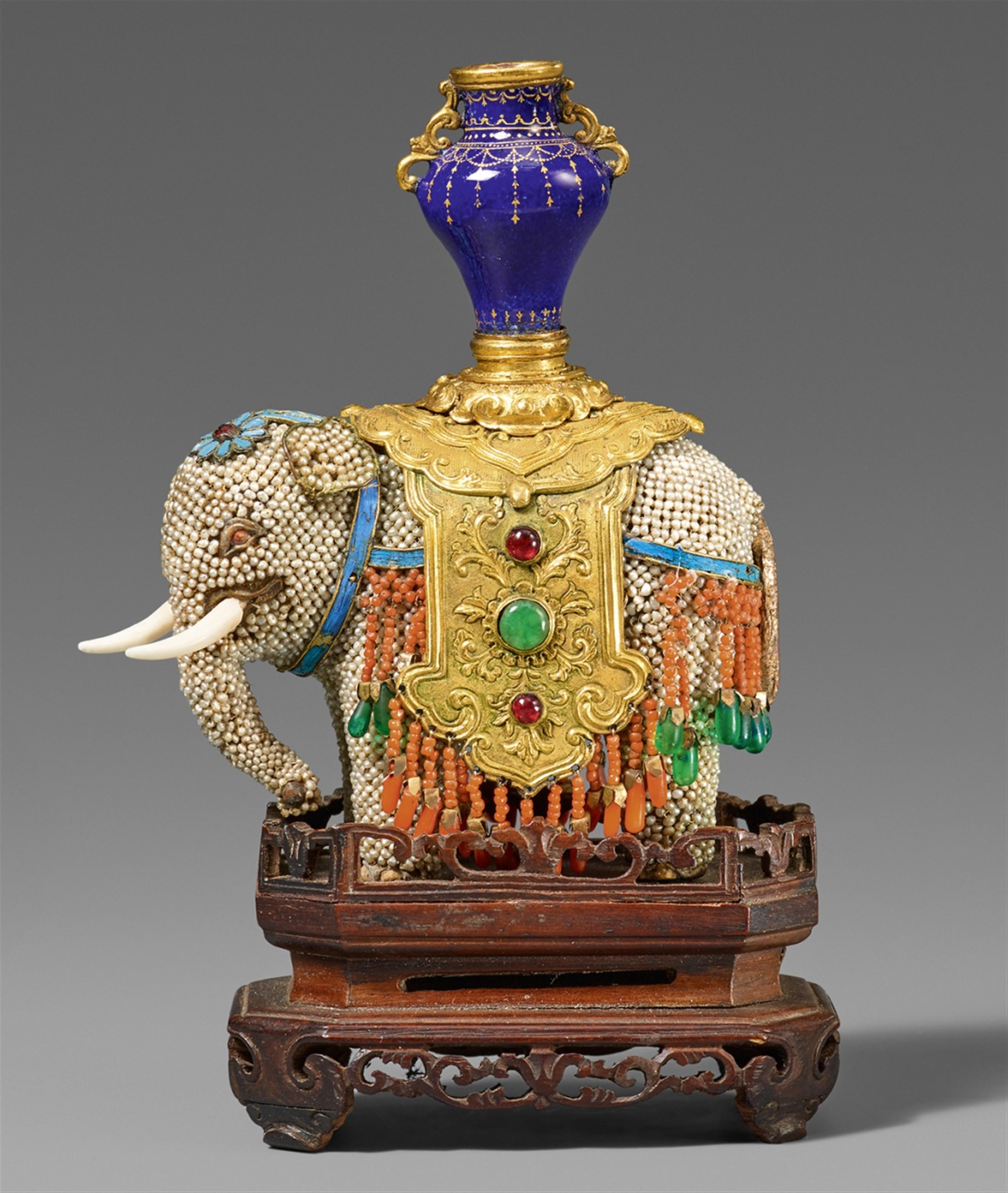A jewelled gilt bronze model of an elephant with trappings in mixed media. 18th century
The body of the elephant is entirely covered by minute seed pearls, the saddle cloth is of gilt-metal with inset gems and glass stones. The animal carries on its back a small meiping vase of dark blue enamel painted with gold, the trappings inlaid with kingfisher feathers, with strings of tiny coral beads ending with a jade-green glass pendant, the teeth of ivory. Fixed on to a carved wooden stand with a balustrade. Chip to the vase. On a carved wooden stand.
Height 13.3 cm (incl. stand), length 9.2 cm
The motif of an elephant with a vase on its back has the auspicious meaning of "peaceful times” (taiping youxiang, when there is peace, there are signs). Objects fashioned in the shape of elephants and carrying a vase were used prolifically in official and private and halls of the Imperial palace. Fashioned in all sizes and materials the larger ones carried fans, insignia or clocks. Small pieces as the present object must have been displayed in carved wooden show cases. Compare the small elephant illustrated in the long scroll entitled “Guwan tu” (Pictures of Ancient playthings) dated to the year 1929 and housed by the British Museum, London. This was made for the Yongzheng emperor (r. 1723-35) as a kind of pictorial inventory of his palace collections. It shows some 250 ceramics, jade and hardstone carvings, bronzes, root wood and other kinds of curios ( see China. The Three Emperors, 1662-1795, Exhibition catalogue, Royal Academy of Arts, London 2005, cat. no. 169)
The refined and masterful technique of mixing various materials can be found on an Imperial jeweled gilt-bronze elephant clock dating from the Qianlong period. The elephant's body is covered with minute seed pearls, embellished with gems, corals, kingfisher feathers in a very similar style to the presently offered piece. Such intricate works of art were produced in workshops operating under the instructions of the Zaobanchu (Palace Workshop) (see Sotheby's, Hong Kong, 8.4.2007, lot 517).
清十八世紀。
木胎放置天青石及翡翠掐絲填滿琺琅太平有象(帶木座)
可比:香港蘇富比2007年4月8日拍賣,編號517與清乾隆見於北京故宮博物院
圖見於紫禁城的日常生活(1988年),第158頁
象馱寶瓶(太平有象)有著“天下太平”的寓意。這種大象通常是用瓷器和琺琅景泰藍成對制成的。在故宮博物院大廳裡有更大的雕像。
而這種小象則在一副名為“古玩畫”的長卷軸中有所描繪。該卷軸的歷史可以追溯到1729年,目前保存在倫敦大英博物館。
此卷軸是作為雍正皇帝(1723-35年間)的宮殿收藏清單而作的(參見:中國的三個皇帝, 1662-1795. 展覽目錄, 皇家藝術學院, 倫敦, 2005年, 目錄號169)。
在乾隆時期的太平有象花瓶上可以看到更為精湛的工藝:花瓶上嵌有寶鐘,整個大象身體綴以淡水珍珠。該鐘象來自宮廷鐘表作坊,下屬制作皇家御用品的專門機構“造辦處“(參見香港蘇富比,8.4.2007,拍品517)。
Literature
Compare an elephant clock sold at Sotheby’s, Hong Kong, 8.4.2007, Lot 517 and an elephant of lapislazuli caparisoned with gold, small pearls and precious stones dating to the Qianlong period, today in the Palace Museum Beijing, ill. in: Daily Life in the Forbidden City, Viking 1988, p. 158

